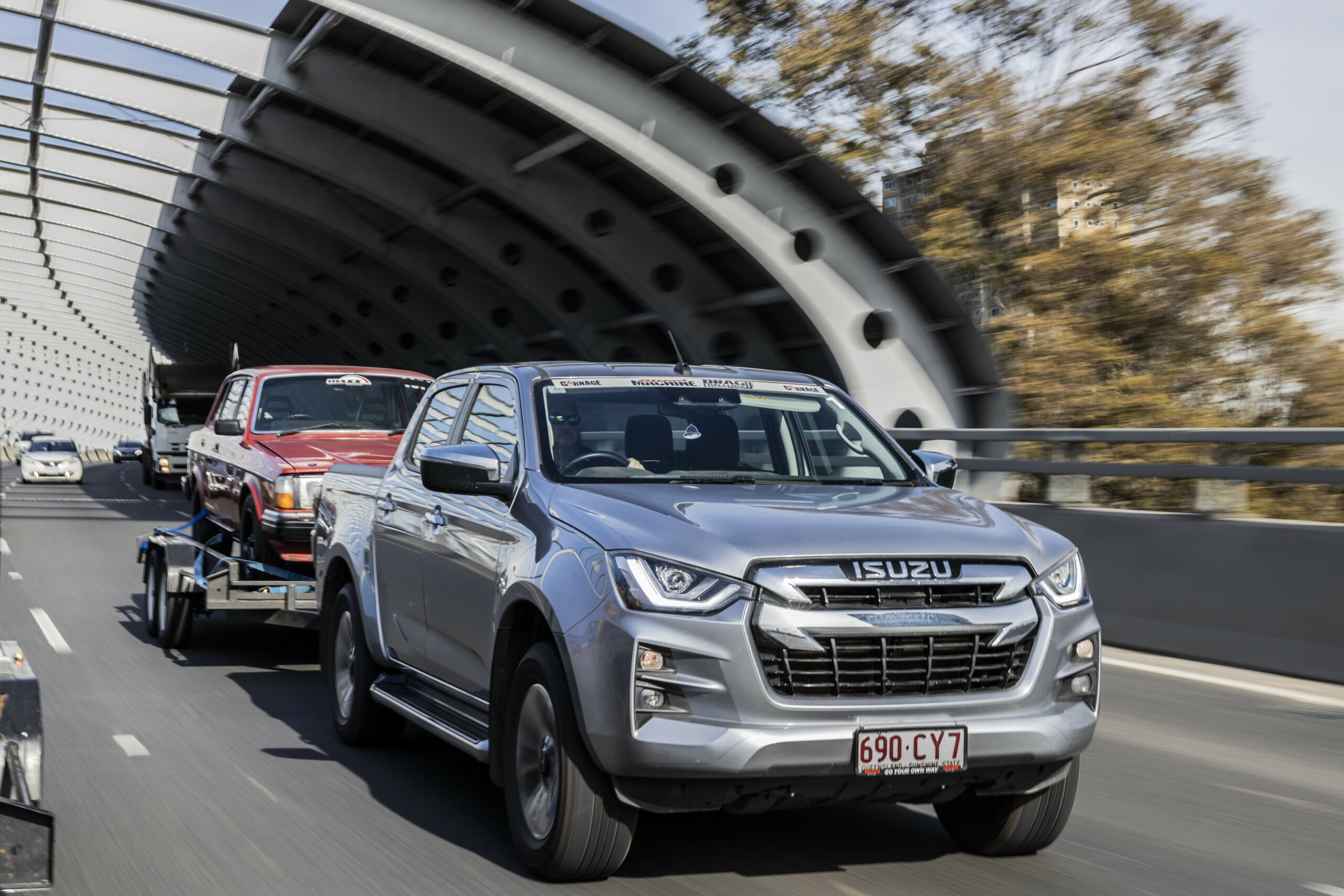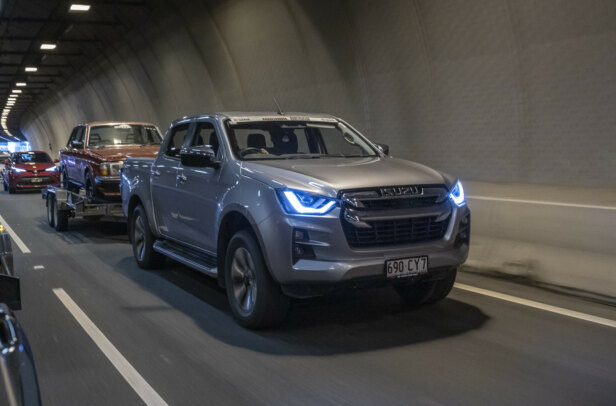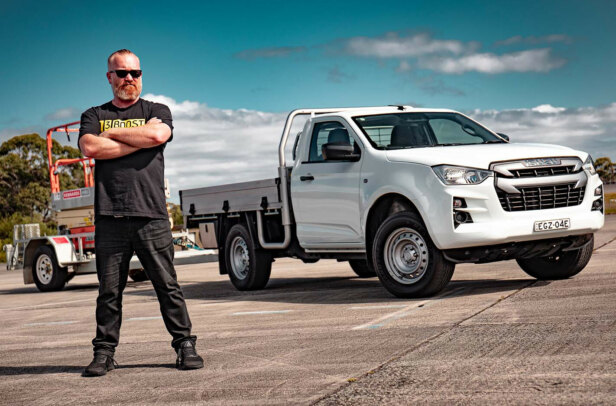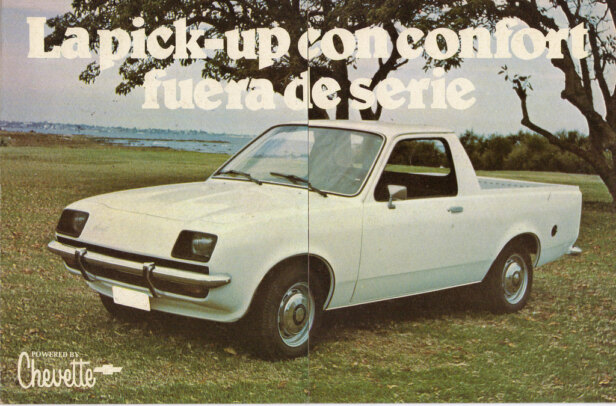Things we like
- Strong 3.0L turbo diesel
- 3.5-tonne towing capacity
- 9in touchscreen with sat-nav
Not so much
- Sensitive auto braking
- Manually locking tailgate
Street machining in the 21st century is a lot different than it was back in the 1980s. The cars were a lot slower back then, and generally easier to cruise to local cars shows.
Fast-forward 40 years and not only are the cars quicker, but the events are bigger and more spread out.
This means there are a lot of car guys and girls who need to tow their rides these days, and for many, the vehicle of choice is a dual-cab ute.
Of course, dual-cab utes have come a long way in the past four decades. Back in the ’80s, they were rough and uncomfortable, often with barely enough power to keep up with traffic.
Nowadays, four-door utes make up at least a quarter of new cars sales. It’s a hugely competitive part of the marketplace that has seen strong growth in the past decade – and one of the most popular dual-cabs is the Isuzu D-Max.
We’ve been fortunate enough to have a D-Max as a long-term tow rig for the past year or so, and whether it’s hauling people, parts or Carnage cars, the D-Max has shrugged off everything we’ve thrown at it.
After all, it has a 140kW 3.0-litre turbo diesel up front that can haul 3.5 tonnes like it’s nothing.
From the highway to the hills, the six-speed automatic transmission has a gear for every situation, and when you haul as many cars around to shows and events as we do, that’s something you learn to appreciate.
In the past five years of building Carnage cars, we’ve driven just about every dual-cab on the market, and we can comfortably say that only a few of them can handle a load with the nonchalance of the D-Max.
However, hauling a load isn’t the whole story. While many might purchase a dual-cab for that reason, most of our own driving is done without anything hooked to the tow bar.
We rack up over 800km per week on Victorian roads during our normal routine, and with the price of fuel these days, that can really add some digits to the weekly budget.
Or it would, if the D-Max wasn’t so good on fuel.
D-Max fuel consumption
A full tank gives us a range of just under 1000km if we’re not towing, which means we only have to stop for diesel once a week.
Most of my weekly commute is freeway stuff and I tend to average out at 7.8L/100km.
The official combined city / highway figures are 7.7L/100km for the manual and 8.0L/100km for the auto, so we’re on the money there.
Naturally, you can expect to double that figure with a car and trailer on the back, but that still seems pretty frugal when you factor in what it would cost to drive a high-horsepower car to the track these days.
That’s without figuring in the stress of carrying extra fuel, tyres, spares and tools in your precious ride – and the fact that the bloody thing might leave you stranded at the track.
A little extra fuel in the D-Max is a small price to pay for the peace of mind of being able to haul your ‘street’ machine to the track, especially given the inherent safety that comes with the D-Max’s Intelligent Driver Assistance System (IDAS).
The IDAS encompasses features like Autonomous Emergency Braking (AEB), Tray Sway Control (TSC), Electronic Stability Control (ESC), driver attention assist and a whole bunch more.
The amount of passive and active safety features is mind-boggling; we think we’re probably safer in the D-Max than we are in our lounge room! I know my house doesn’t have a five-star ANCAP rating.
Of course, all that safety stuff does come with its own issues, and probably our most obvious complaint with the D-Max is that the Autonomous Emergency Braking can be a bit sensitive.
We’ve had it kick in several times in bumper-to-bumper traffic when it really didn’t need to, and it even activated on a sharp bend when it didn’t like the guardrail on the side of the road curving around in front of the car. But it’s more of an annoyance than anything, and if you modify your driving behaviour to compensate, it’s not a problem at all.
The good news is that the Lane Assist feature can now be turned off with one touch of a button on the steering wheel, should you so desire. Previously, this involved cycling through menus in the trip computer. Big tick!
Inside, the D-Max is decked out as you would expect from a modern off-roading SUV, and our LS-U variant is probably a bit better than most.
Up front there is a nine-inch touchscreen – up from seven inches on the lower-spec models – and a leather steering wheel.
The dual-zone climate control serves us well in Melbourne, especially during those cold winter months, and the eight-speaker sound system keeps us entertained on the long commute to and from work. Cup holders and storage bins are both plentiful and appreciated.
Stepping outside, our D-Max LS-U comes standard with side steps and 18-inch alloy wheels, along with colour-coded bumpers, chrome door handles and grille, and a factory-fitted tow bar.
We’ve also got a locking, concertina-style roll-back tonneau cover that’s perfect for making sure all our tools and spares come home with us after we’re done at the track.
The only downside of the tonneau is that it takes up some load room, but it’s a comprimise we’re happy to wear for the kind of work we do.
Overall, the D-Max is a solid performer that will do basically anything you ask of it. It’s roomy, comfortable and powerful, and yet economical as well, and we’re glad to have it.
If you’re in the market for a vehicle that can haul your kids to school during the week and your street machine to the track on the weekend, the D-Max deserves consideration.
2022 Isuzu D-Max LS-U Crew Cab specifications
| Body | 4-door, 5-seat dual-cab ute |
|---|---|
| Drive | four-wheel |
| Engine | 3.0-litre inline four-cylinder turbo-diesel |
| Transmission | 6-speed automatic |
| Power | 140kW @ 3600rpm |
| Torque | 450Nm @ 1600-2600rpm |
| Weight | 2112kg |
| L/W/H | 5270/1870/1790mm |
| Wheelbase | 3125mm |
| Ground clearance | 240mm |
| Tracks | 1570mm |
| Turning circle | 12.5 metres |
| Tray length | 1570mm |
| Payload | 988kg |
| Towing capacity (braked) | 3500kg |
| Fuel tank capacity | 76L |
| Fuel Economy (claimed) | 8.0L/100km |
| Fuel Economy (as tested) | 8.2L/100km |
| Suspension | independent coil springs (f); Leaf springs (r) |
| Steering | electric power steering |
| Brakes | 320mm ventilated discs (f); drum brakes (r) |
| Wheels | 18-inch alloy, full-size spare |
| Tyres | 265/60 R18 highway-terrain |
| Price | $59,000 + plus on-road costs |





Comments